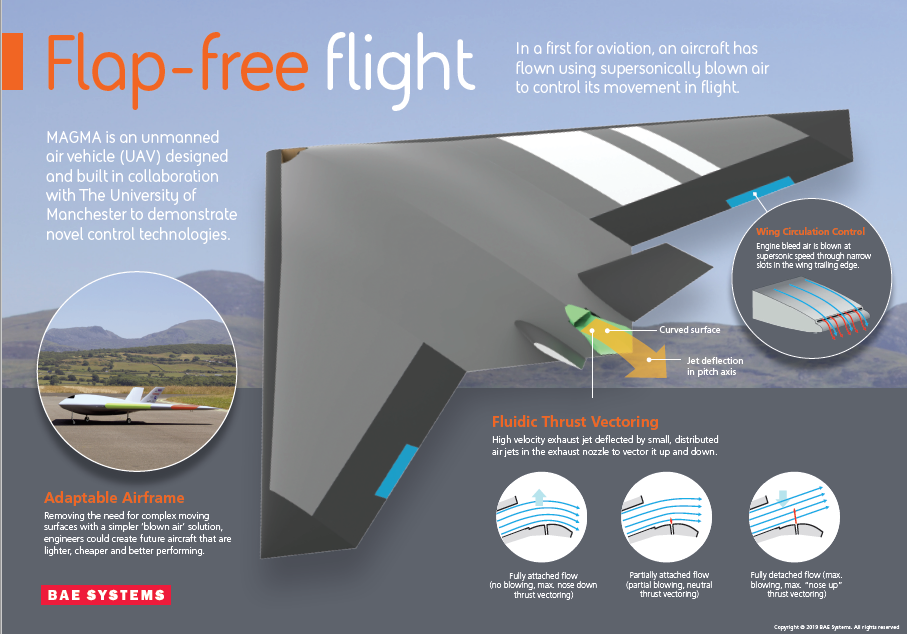Drone development undertaken by BAE Systems in collaboration with The University of Manchester has reached a new landmark.
Earlier in May this year, the MAGMA unmanned aerial vehicle (UAV) successfully completed trials proving the capabilities of its “flap-free” flight technologies.
As a result, MAGMA is believed to have become the first vehicle in aviation history to be manoeuvred in flight using supersonically blown air, a technology which improves the complicated task of controlling an aircraft at low-speeds.
Flap-free blown air control
In conventional airplanes, wing flaps are deployed to increase the lift of an aircraft during takeoff and mid-flight when extra drag is required. Necessarily extendable and retractable on demand, the flaps are a complex construction, relying on the interaction between many different components.
Aiming to simplify and compact this feature for a UAV, The University of Manchester and BAE are looking to blown air technologies instead of traditional wing flaps. Though the concept of blown air control has been tested in aviation since the Second World War, MAGMA’s blown air technology differs in the speed at which the air is delivered, and also the size of the system it is used in.
In the latest trials of the MAGMA, two so-called “flap-free” blown air methods were demonstrated:
– Wing Circulation Control, described as “Taking air from the aircraft engine and blowing it supersonically through narrow slots around a specially shaped wing tailing edge in order to control the aircraft.”
– And, Fluidic Thrust Vectoring, “Controlling the aircraft by blowing air jets inside the nozzle to deflect the exhaust jet and generate a control force.”

Potential for Future Combat Air Systems
Blown air solutions developed by the MAGMA team are the product of a longstanding partnership between BAE Systems and a team at The University of Manchester led by senior academic Bill Crowther. Describing how this project has developed over the years Crowther, following the latest test flights, commented, “We made our first fluidic thrust vectoring nozzle from glued together bits of plastic and tested it on a hair drier fan nearly 20 years ago.”
“Today BAE Systems is 3D printing our components out of titanium and we are flight testing them on the back of a jet engine in an aircraft designed and built by the project team. It doesn’t get much better than that.”
3D printing components for the MAGMA is fundamental to streamlining its design, as well as improving inertia, and reducing cost, mass and radar cross section. Other defense projects applying additive manufacturing to UAV development include an agreement between Titomic and TAUV, 3D printed antennas for the U.S. Air Force, and DARPA’s TERN program.
Data generated from the MAGMA project will be used by BAE to influence future research programs, and potentially the development of a Future Combat Air System.
Vote for your 2019 Aerospace Application of the Year in the 3D Printing Industry Awards.
For more regular 3D printing updates subscribe to the daily 3D Printing Industry newsletter, follow us on Twitter, and like us on Facebook. Find talent for a project, or advance your career in 3D printing – join 3D Printing Jobs to apply and advertise.
Featured image shows the MAGMA UAV ready-to-fly. Photo via BAE Systems



